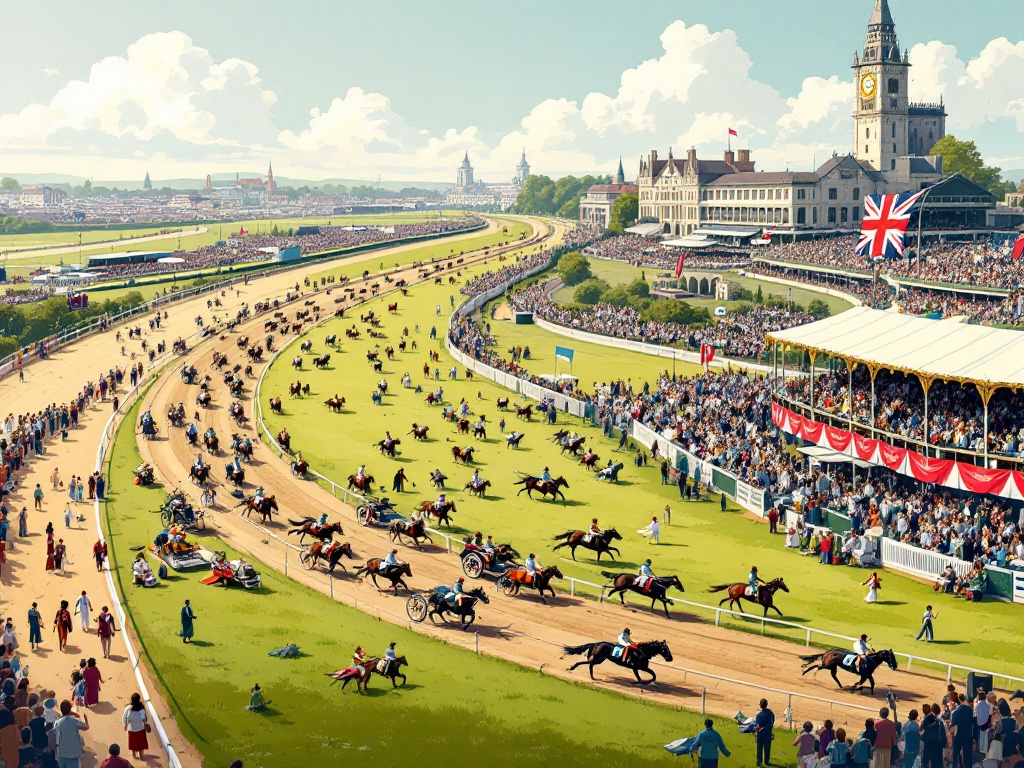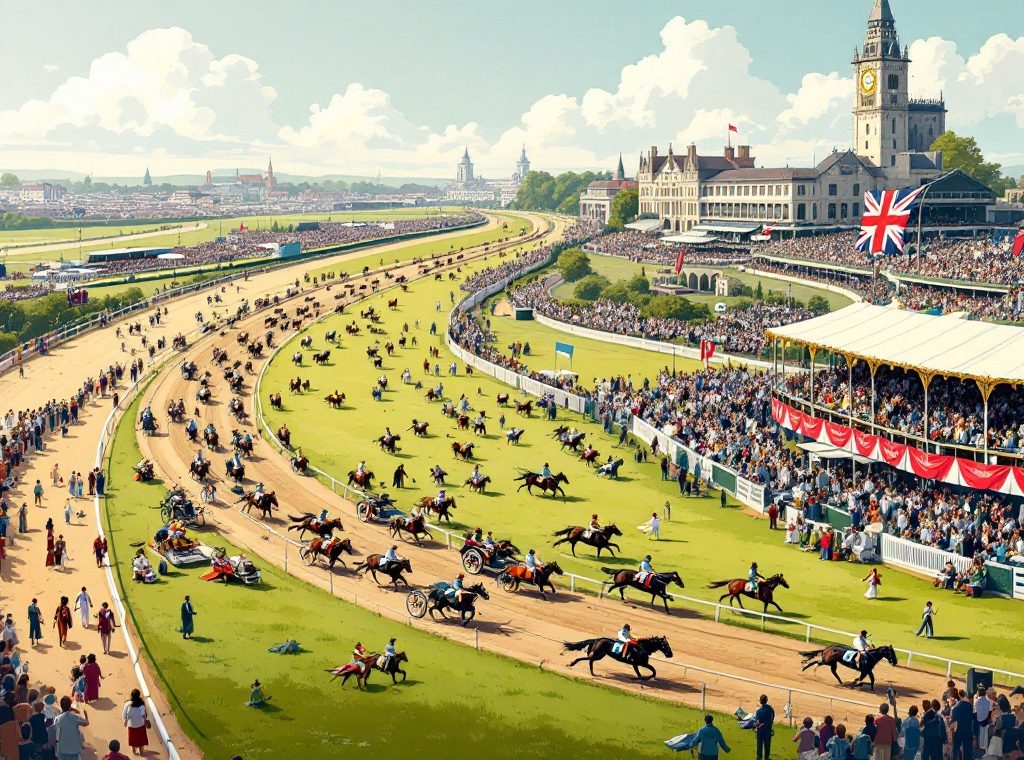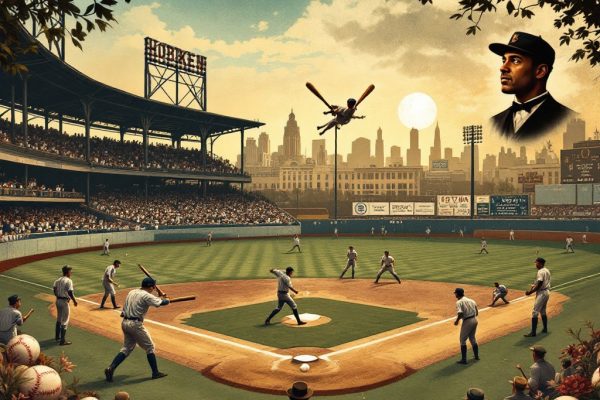History of Horse Racing in Great Britain
From Roman chariots to royal Ascot, explore the thrilling evolution of British horse racing! Discover the sport’s rich history, from medieval knights to the birth of the Thoroughbreds. Learn about iconic races like the Derby and Grand National, and the legendary figures who shaped the sport. Delve into the modern challenges and technological advancements impacting this exciting world. Giddy up and discover the captivating story of British horse racing!
Important information

- Horse racing in Britain has a long history, dating back to the 12th century with influences from Roman chariot races and medieval equestrian contests.
- The Jockey Club, formed in 1750, standardized racing rules and practices, ensuring fair competition and solidifying the sport’s structure.
- Famous races like the Derby, St. Leger Stakes, and the Grand National have cemented horse racing’s place in British culture and gained international appeal.
- Key figures like Lester Piggott (jockey) and Vincent O’Brien (trainer) have shaped the sport, while horses like Eclipse and Red Rum have become iconic.
- Modern horse racing faces challenges such as doping and animal welfare concerns, but technological advancements offer solutions for monitoring and data analysis, contributing to a more ethical and sustainable future.
History of Horse Racing in Great Britain
From Roman chariot races to knights on horseback, horse racing has deep roots in Great Britain.
By the 12th century, mounted contests foreshadowed modern horse racing, with the first recorded race in 1174.
Organized racing emerged in the 16th century, with a notable race documented in 1519.
The 17th century revolutionized the sport with the introduction of Thoroughbreds, formal rules, and the popularization of betting.
The Jockey Club’s formation in 1750 standardized English racing, ensuring fair competition.
The following century saw the rise of iconic races like the Derby and St. Leger Stakes, captivating everyone from royalty to commoners and cementing horse racing’s place in British culture.
Origins and Early History
Horse racing’s professional origins can be traced back to 12th-century Great Britain under King Henry II.
Returning knights introduced swift Arabian horses, sparking a passion for competitive racing.
Organized races gained popularity during James I’s reign, with Newmarket emerging as a key racing center.
This solidified the sport’s place in British culture.
Influence of Monarchs and Aristocracy
British horse racing’s prestige is deeply rooted in royal patronage. Queen Anne’s establishment of Ascot Racecourse in 1711 initiated the sport’s connection with royalty, ultimately leading to its designation as “The Sport of Kings.” The aristocracy’s enthusiastic support further cemented this image.
Evolution of Racing Competitions
British horse racing’s rich history traces back from informal competitions to the structured sport we know today. Early races, influenced by Roman chariot races, evolved into displays of equestrian prowess by knights during 12th-century tournaments. The sport’s popularity exploded in the 16th century, paving the way for established rules and dedicated racecourses in the 17th century.The 1750 formation of the Jockey Club standardized racing practices throughout England. The 18th century saw the emergence of the Thoroughbred breed and the introduction of formal betting, solidifying the sport’s distinct character. Technological advancements, including timing systems and broadcasting, broadened horse racing’s reach, making it accessible to a global audience.
Key Developments in British Horse Racing
- Early races (influenced by Roman chariot races).
- 12th century: Knights displayed equestrian skills in tournaments.
- 16th century: Surge in horse racing’s popularity.
- 17th century: Formal rules and racecourses established.
- 1750: Jockey Club formed, standardizing racing.
Modern Horse Racing
- 18th century: Rise of the Thoroughbred breed and structured betting.
- Technological advancements (timing systems, broadcasting) increased accessibility.
- Prestigious events (Derby, Grand National) maintain popularity.
- Significant entertainment and revenue source.
Today, British horse racing thrives as a major entertainment and revenue source, with iconic events like the Derby and Grand National continuing to captivate audiences worldwide.
Types of Horse Racing
Horse racing offers a thrilling array of formats, including Flat Racing, National Hunt Racing, and Point-to-Point. Flat racing, a pure test of speed and stamina, occurs on level ground. National Hunt racing elevates the excitement with jumps, featuring both hurdles and steeplechases. Point-to-Point racing focuses on amateur steeplechases, often serving as a starting point for future National Hunt professionals. Steeplechases are known for their larger fences and longer distances, presenting a unique challenge within the sport.
Flat Racing
A test of speed and stamina on level ground.
National Hunt Racing
Racing with jumps, including hurdles and steeplechases.
Point-to-Point Racing
Amateur steeplechases, a training ground for National Hunt professionals.
Steeplechases
Races with larger fences and longer distances, a distinct challenge in the sport.
Flat Racing
Flat racing offers thrilling displays of speed and stamina on level tracks. These prestigious races showcase famous horses and jockeys, captivating audiences worldwide.
National Hunt Racing
National Hunt racing focuses on jumping, with horses clearing hurdles and larger fences. This exciting sport differs greatly from flat racing, requiring specific skills, strategies, and training. Even the horses’ breeding is adapted to jumping challenges.
Point-to-Point and Steeplechase
Point-to-Point is a thrilling amateur horse racing sport held on cross-country courses with natural, uneven terrain. It tests the strength, precision, and bravery of horse and rider.
Steeplechases are professional races over similar terrain, but they also include obstacles like fences and ditches. Both Point-to-Point and Steeplechases are considered part of National Hunt racing, a demanding sport.
Famous Racecourses and Events
Newmarket, the heart of British horseracing, is home to the National Stud and the prestigious Jockey Club.
Ascot Racecourse, known for its ties to the British Royal Family, attracts large crowds, especially for the renowned Royal Meeting.
Aintree’s Grand National, a challenging steeplechase with demanding jumps, captivates a global audience.
Newmarket and Its Significance
Newmarket, the heart of British horseracing, hosted its first recorded race meeting in 1622. The town boasts two major courses: the Rowley Mile and the July Course. It also houses numerous training yards and stables, cementing its position as a key industry center. Prestigious races, such as the 2000 and 1000 Guineas, are run on Newmarket’s Rowley Mile.
Ascot and Royal Connections
Ascot Racecourse, founded by Queen Anne in 1711, quickly became famous for its royal ties. Its prestige is especially associated with Royal Ascot, a glamorous racing event that draws prominent attendees. This spectacle, rich in tradition and pageantry, holds significant social importance.
The Grand National and International Appeal
The Grand National captivates a global audience of roughly 600 million, drawn to the race’s notoriously challenging and unique course. Its demanding nature has earned it international acclaim.
Notable Figures and Bloodlines
British horse racing boasts legendary figures, both equine and human. Iconic horses include Eclipse, whose bloodline shaped modern thoroughbreds, and Red Rum, the three-time Grand National champion. Among jockeys, Lester Piggott, a nine-time Epsom Derby winner, and Gordon Richards, renowned for his career wins record, stand out. Trainers such as Vincent O’Brien, with six Epsom Derby victories, and Aidan O’Brien, a prolific winner of classic races, have also left an enduring legacy. Furthermore, the Jockey Club, founded in 1750, plays a crucial role in regulating the sport and maintaining its integrity. These figures continue to inspire and shape the world of horse racing.
Key Horses and Their Impact
Eclipse, dominating the 18th century, established a vast legacy through his numerous winning offspring.
Northern Dancer made his mark with Kentucky Derby and Preakness Stakes victories, later becoming a prominent sire.
Red Rum’s three Grand National wins in the 1970s elevated jump racing’s profile.
Desert Orchid captivated audiences in the ’80s and ’90s with charisma and exceptional jumping prowess.
Frankel, undefeated in all 14 races, solidified his place among the greatest flat racers of all time.
Influential Jockeys and Trainers
Lester Piggott, a true racing icon, conquered the Epsom Derby a remarkable nine times. Sir Gordon Richards secured an astounding 26 champion jockey titles.
Trainers are equally crucial to horse racing. Vincent O’Brien trained six Epsom Derby winners. Aidan O’Brien continues the family’s winning tradition, training numerous champion horses.
The Role of The Jockey Club
Founded in 1750, the Jockey Club governs British horse racing. It establishes and enforces the rules to ensure fair play and integrity within the sport. The Jockey Club also maintains the thoroughbred registry and standardized racing practices, elevating its cultural significance in Britain.
Cultural and Social Impact
Deeply ingrained in British culture, horse racing, often called “The Sport of Kings,” has evolved from its aristocratic roots to become a beloved pastime enjoyed by a diverse fan base. A thrilling spectator sport, it holds a prominent place on the British social calendar, with major events like Royal Ascot and the Grand National attracting massive crowds and significant media coverage.
The Sport of Kings and Aristocracy
Horse racing, known as the “Sport of Kings,” has deep roots in royalty and aristocracy. Kings and nobles not only shaped the sport, but also influenced its rules, evolution, and prestigious reputation. This royal legacy continues to impact horse racing’s cultural significance today.
Horse Racing as a Spectator Sport
Horse racing is hugely popular in Great Britain, second only to football in attendance. Its diverse fanbase fosters a strong sense of community, and major races become massive events, drawing enormous crowds and boosting the sport’s social impact. Horse racing is vital to British society.
Modern Challenges and Developments
The welfare of horses in racing is a paramount concern, particularly regarding doping. Fortunately, technological advancements like sensor-equipped saddles and GPS trackers offer potential solutions. These tools analyze performance and mitigate injuries, encouraging stricter regulations and fairer competition.
For the sport to thrive, it must embrace sustainability, encompassing both economic and environmental responsibility. Public perception plays a vital role, so addressing ethical concerns is crucial for its long-term survival.
The industry must tackle challenges like doping control and horse welfare head-on. New technologies and robust regulations are key to overcoming these hurdles. Ultimately, the future of horse racing depends on ethical practices and maintaining a positive public image.
Prioritize horse welfare. Focus on mitigating injuries and implementing stricter regulations for doping control.
Embrace technology. Utilize sensor-equipped saddles and GPS trackers to analyze performance and prevent injuries.
Ensure sustainability. Focus on both economic and environmental responsibility for the long-term health of the sport.
Address ethical concerns. Maintain public trust by actively addressing ethical concerns and promoting transparency.
Uphold a positive public image. The future of horse racing hinges on ethical practices and a positive public perception.
Animal Welfare and Doping Issues
Animal welfare is a crucial concern in horse racing, particularly regarding the significant problem of doping. Administering drugs to enhance performance raises serious ethical questions and jeopardizes the horses’ well-being. The racing industry faces mounting pressure to implement stricter regulations and elevate welfare standards. However, progress remains slow.
Technological Advances and Regulation
Technology is transforming horse racing. GPS trackers and sensor-equipped saddles provide invaluable data on horse performance and health, benefiting trainers and owners. Photo-finish cameras and precise timing systems guarantee accurate results, eliminating disputes. Online betting and virtual reality enhance the fan experience.
Advantages of Technology in Horse Racing
- GPS trackers and sensor-equipped saddles provide data on horse performance and health, benefiting trainers and owners.
- Photo-finish cameras and precise timing systems guarantee accurate results and eliminate disputes.
- Online betting and virtual reality enhance the fan experience.
Challenges of Technology in Horse Racing
These advancements present challenges for regulatory bodies like the British Horseracing Authority (BHA). They must adapt to technology’s impact on data analysis and racing integrity by developing new rules and regulations. This is crucial to ensure fair play and safeguard the sport’s future.
Future Prospects and Sustainability
Modern sports face complex challenges, demanding ethical conduct and responsible practices. Some of these challenges include doping and animal welfare. Technology offers innovative monitoring and data analysis tools to ensure fairness and protect animal well-being. Reaching younger audiences and promoting sustainability are also crucial for the sport’s future. This future depends on balancing tradition with modern values through responsible management.












